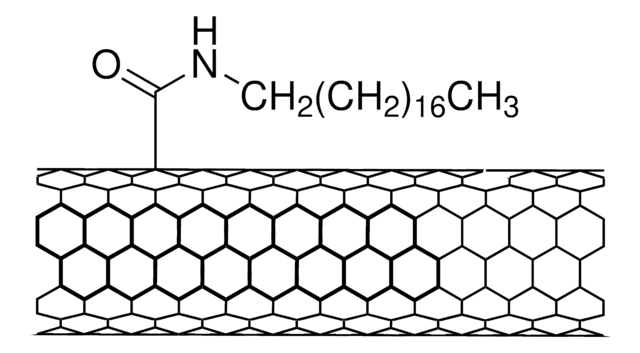639230
Carbon nanotube, single-walled
polyaminobenzene sulfonic acid functionalized, 75-85%carbon basis, D × L 1.1 nm × 0.5-1.0 μm , bundle dimensions
Synonym(s):
Carbon nanotube, single-walled, PABS functionalized, SWNT, PABS functionalized
About This Item
Recommended Products
product name
Carbon nanotube, single-walled, polyaminobenzene sulfonic acid functionalized, 75-85% carbon basis, D × L 1.1 nm × 0.5-1.0 μm , bundle dimensions, avg. no. of layers, 1
Assay
75-85% carbon basis
form
powder
mol wt
average Mw 400-600 g/mol (PABS)
feature
avg. no. of layers 1
extent of labeling
65% (PABS, typical)
D × L
1.1 nm × 0.5-1.0 μm , bundle dimensions
impurities
4% metals
solubility
ethanol: 0.05 mg/mL
DMF: 0.1 mg/mL
H2O: 5.0 mg/mL (As determined by near-IR absorbance spectroscopy.)
functional group
sulfonic acid
Related Categories
General description
Application
Packaging
Preparation Note
Analysis Note
Signal Word
Warning
Hazard Statements
Precautionary Statements
Hazard Classifications
Eye Irrit. 2 - STOT SE 3
Target Organs
Respiratory system
Storage Class Code
11 - Combustible Solids
WGK
WGK 3
Flash Point(F)
Not applicable
Flash Point(C)
Not applicable
Personal Protective Equipment
Regulatory Listings
Regulatory Listings are mainly provided for chemical products. Only limited information can be provided here for non-chemical products. No entry means none of the components are listed. It is the user’s obligation to ensure the safe and legal use of the product.
JAN Code
639230-VAR:
639230-50MG:
639230-BULK:
639230-100MG:
Certificates of Analysis (COA)
Search for Certificates of Analysis (COA) by entering the products Lot/Batch Number. Lot and Batch Numbers can be found on a product’s label following the words ‘Lot’ or ‘Batch’.
Already Own This Product?
Find documentation for the products that you have recently purchased in the Document Library.
Customers Also Viewed
Articles
Carbon nanotubes are materials that possess remarkable properties and offer extraordinary possibilities.
Carbon nanotubes (CNTs) have received much attention since their discovery in 1991 by Sumio lijima1 due to their excellent mechanical, electrical, and optical properties.
A nanocomposite is typically defined as a mixture between a host material (e.g., polymer matrix) and nanofillers with at least one dimension of less than 100 nm.
SWCNTs show promise in FETs, solar cells, and photodetectors due to their ultrafast charge transport mobility.
Our team of scientists has experience in all areas of research including Life Science, Material Science, Chemical Synthesis, Chromatography, Analytical and many others.
Contact Technical Service











